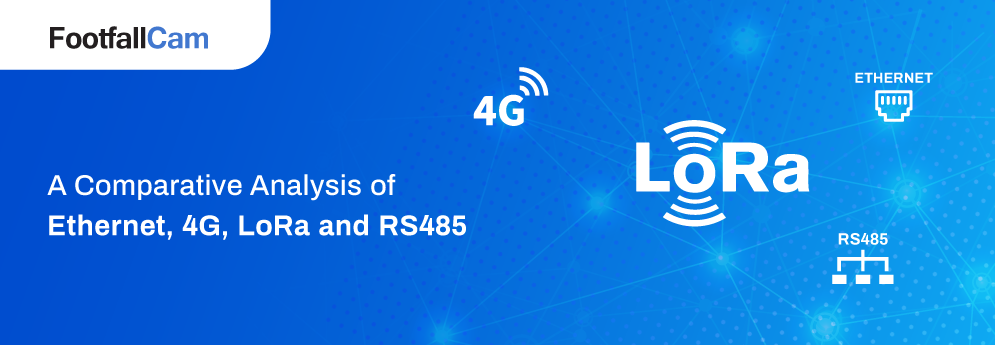Choose the networking technology that aligns with your people counting system, setting the stage for seamless operations and reliable data transfer.

When comparing Ethernet, 4G, LoRA, and RS485 for networking a people counting system, several factors should be considered, including speed, range, reliability, scalability, cost, and deployment feasibility. Here’s an overview of each networking technology:
Ethernet: Ethernet is a widely used wired networking technology that provides high-speed data transfer over a local area network (LAN). It offers reliable and stable connectivity, typically with gigabit or higher speeds. Ethernet is suitable for fixed installations where cabling can be easily deployed. It provides low latency and high bandwidth, making it suitable for demanding applications such as real-time data analysis. However, Ethernet may require additional infrastructure installation and is limited by the physical reach of the cabling.
4G (LTE): 4G, also known as LTE (Long-Term Evolution), is a cellular network technology that provides wireless data connectivity over a wide area. It offers high-speed data transfer and wide coverage, making it suitable for remote or mobile deployments where wired connectivity is not feasible or cost-effective. 4G networks can provide reliable connectivity, but performance may vary depending on network congestion and signal strength. While 4G offers flexibility and mobility, ongoing data costs and potential signal fluctuations are important considerations.
LoRA (Long Range): LoRA is a low-power, wide-area network (LPWAN) technology designed for long-range wireless communication. It provides low data rates but with an extended range, making it suitable for applications where power efficiency and long-distance connectivity are important. LoRA is well-suited for low-bandwidth IoT applications, including people counting systems in areas with minimal infrastructure. However, its limited data rate may not be suitable for scenarios that require high-speed data transfer or real-time communication.
RS485: RS485 is a serial communication standard commonly used for short- to medium-range data transmission. It enables reliable communication over long distances (up to several kilometers) and supports multi-drop connections, allowing multiple devices to be connected on a single bus. RS485 is often used for industrial applications and can provide robust and noise-immune communication. However, it requires dedicated cabling and may have limited data transfer rates compared to Ethernet or wireless technologies.
The choice of networking technology for a people counting system depends on factors such as the deployment environment, infrastructure availability, data transfer requirements, mobility needs, and budget constraints. Ethernet provides high-speed and reliable connectivity for fixed installations. 4G offers flexibility and wide coverage, suitable for mobile or remote deployments. LoRA is ideal for low-power, long-range applications without extensive infrastructure. RS485 is well-suited for industrial environments requiring robust and long-distance communication. Consider these factors to determine which technology best suits your specific needs and constraints.















